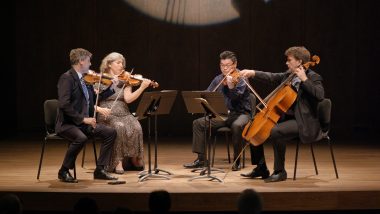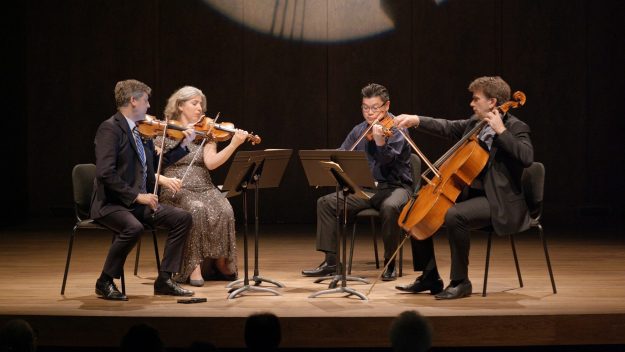 Canada Beethoven, Montreal Chamber Music Festival 2024: Ehnes Quartet (James Ehnes, Amy Schwartz Moretti [violin], Che-Yen Chen [viola], Edward Arron [cello]), Milena Pajaro-van de Stadt (viola). Bourgie Hall, Montréal Museum of Fine Arts, Montreal. (LV)
Canada Beethoven, Montreal Chamber Music Festival 2024: Ehnes Quartet (James Ehnes, Amy Schwartz Moretti [violin], Che-Yen Chen [viola], Edward Arron [cello]), Milena Pajaro-van de Stadt (viola). Bourgie Hall, Montréal Museum of Fine Arts, Montreal. (LV)

21.6.2024: Beethoven – String Quartets No.8 in E minor & No.9 in C major, Op.59, Nos. 2&3 ‘Razumovsky’
22.6.2024: Beethoven – String Quartet No.7 in F major, Op.59, No.1 ‘Razumovsky’; String Quintet in C major, Op.29
The last time I was at Denis Brott’s Montreal Chamber Music Festival, in 2019, violinist James Ehnes played the complete cycle of Beethoven violin sonatas with pianist Andrew Armstrong. This year, Ehnes returned with his quartet in Beethoven of a different stamp and significance. We would hear how the expansively flowing style of his rarely performed String Quintet in C major with two violas contrasted sharply with the terse language of the six Op.18 quartets written a few years earlier and would find its mature culmination five years later in the three Razumovskys. It was all performed with care and attention to the composer’s dynamics, articulation and expressive markings, as if the musicians were searching for the emotions he was feeling behind the notes: it was like reading the score and hearing the music come to life. I had the good fortune to attend the concerts and several of their rehearsals.
On the first night, the opening, questioning phrases of the second Razumovsky held the audience in suspense before the energy surged. Ehnes sang out the long lines, and his quartet’s hair-trigger timing swept the narrative away straight through until the exquisite voicing of the magical harmonic transformations in the coda. Ehnes and the second violinist Schwartz Moretti could not be better matched; they played the slow movement under Beethoven’s hypnotic spell, ending in a long, lovely line of simple sighs. The ‘Thème Russe’ in the Allegretto was too fast to be intoxicating, but who cared when the Finale exploded at the end so brilliantly under Ehnes’s tight yet totally flexible and exhilarating control. In the third Razumovsky, Beethoven’s lapidary affection for clear organic growth underlined just how perfect the players were for their positions. If you played a string instrument, just watching the quartet’s fingerings and bowings constituted a virtual master class, especially in the iconic last movement which they brought home with speed and, where they could, warmth.
Like Adolf Busch, Ehnes is a virtuoso committed to chamber music, particularly the string quartet. And since many of Beethoven’s most highly charged, emotional outbursts in the quartets are so difficult that only such a virtuoso can soar above the ensemble as Beethoven imagined it, blazing from his first inspiration, the performances both nights also soared. Cellist Ed Arron has a large, enthusiastic sound and good nature that had him stomping his foot at times and adding all the good nature Beethoven also found in the instrument alongside its quiet, soulful lines and occasional wild abandon. Amy Schwartz Moretti is indivisible from the score, whether in the shadows or the limelight, with a striking presence that belies her rank. In a demonstration of how formidable a violinist she is, her performance leading Bach’s Fifth Brandenburg Concerto the next afternoon would show off her command of Baroque Affekt and gesture. The new violist, Che-Yen Chen, was playing on a new instrument by Samuel Zygmuntowicz which was as bold-sounding as he was, contributing rich colors and different planes of sound, sometimes searingly romantic, sometimes slashing, as in the enigmatic Andante con moto of No.3.
The Ehnes Quartet began the second night with the first Razumovsky which they took at lithe allegro speeds, warm and sexy at times and spiked by fierce sforzandos. They paced the high dramatic points superbly and peaked in triumph at bar 254. The Scherzo was thrilling, exhilarating, violent at times, exploiting the myriad contrasts of texture and intensity. The Adagio molto was deeply, personally sad, after which Arron’s jaunty cello theme opening the Finale embraced all humanity.
The relatively obscure String Quintet Op.29 which ended the evening is one of Beethoven’s most attractive works, and it shows his command of Mozart’s Olympian style and Haydn’s joyful spirit. The Ehnes Quartet, joined by violist Milena Pajaro-van de Stadt, laid out the long-lined first movement as if C major could last forever, and Ehnes led the second movement’s outpouring of song with disarming simplicity. After Arron’s miraculous rising from the ensemble at the end of the Trio came the wonderful absurdities of an insanely fast Finale, which accelerated even more as they drove together through the fugue after the double bar. They were fast and kittenish in the last of the dance interludes before slipping through one of Beethoven’s most magical hesitations and finishing in an electric rain of 16th-notes.
After Montreal, the quartet moved on to Macon, Georgia, to record the same works for their Beethoven cycle on Onyx. The first installment since 2021 and the first with their new violist, will be released in 2025.They will tackle the final installment in their cycle, the six quartets of Op.18, in two years.
The evening concerts were preceded by free noon-hour concerts by winners of the Canada Council for the Arts Musical Instrument Bank Competition. The prizes are the usage for three years of Strads and other fine instruments which enable dreams – and careers – to happen. The music included transcendent Leclair, unleashed Xenakis, movements from a Mozart divertimento that had me wanting more, just the right amount of pleasantly inconsequential Berio, Jessie Montgomery showing what can be done with a fiddle, and Mendelssohn showing what can be done with a string quintet showcasing future stars.
Laurence Vittes
